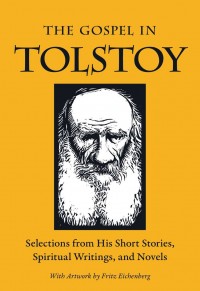 “The Gospel in Tolstoy: Selections from His Short Stories, Spiritual Writings and Novels”
“The Gospel in Tolstoy: Selections from His Short Stories, Spiritual Writings and Novels”
by Leo Tolstoy; edited by Miriam LeBlanc.
Plough Publishing (Walden, New York, 2015).
342 pp., $18.
This is at once a wonderful and a disappointing collection of Leo Tolstoy’s writings. The book opens with a short biographical sketch and concludes with an afterword (“Finding the Gospel in Tolstoy”) by Eberhard Arnold. “Christians,” he writes, “must join Tolstoy in confronting humankind with the witness to a life without private property and without weapons.” Arnold (1883-1935) was the founder of the Bruderhof, the community behind Plough Publishing. The selections are organized thematically — finding God, love of neighbor, peace and nonviolence, forgiveness, living simply and the way of the kingdom.
The book is wonderful because it is always good to read Tolstoy, and this volume brings together a wide variety of his writing. There are excerpts (“How to Resist Evil”) from “The Kingdom of God is Within You,” an important essay that had a significant influence on, among others, Mohandas Gandhi, Albert Schweitzer and the Rev. Martin Luther King Jr.
[hotblock]
The book includes memorable folk tales (“The Empty Drum”) and legends (“The Three Hermits”), as well as moving stories (including “What Men Live By” and “Where Love Is, God Is”) as well as selections from Tolstoy’s great novels: “War and Peace,” “Anna Karenina” and “Resurrection.” “The Gospel in Tolstoy” is enhanced by Fritz Eichenberg’s evocative woodcuts. It is good to have this in one volume.
Unfortunately this very rich material is poorly served by the book’s significant shortcomings. The reader should have been given some understanding of the criteria that was used in making selections; without it, the book does not cohere well. This is especially problematic with the short excerpts from the novels, prefaced by brief explanations. Anyone unfamiliar with the novels could not begin to appreciate the complex characters and situations on the basis of these shorthand descriptions.
The thematic structure seems arbitrary and there are excerpts that would be suitable in more than one section. For example, the story “The Repentant Sinner” is in the forgiveness section but it could just as easily have been placed under finding God; in fact, that is the ultimate theme of most of the texts, as it was in long periods of Tolstoy’s life.
“The Gospel in Tolstoy” looks and feels as if it was compiled with a minimal amount of effort (and minimal cost — all of the translations used in this book are in the public domain). An edited book like this really needs a more substantial introduction, a fuller explanation of the historical, biographical and theological context out of which Tolstoy wrote. There is an evident didactic component to what was chosen and how it was organized but we are never given an explicit discussion of how the selections build on the purpose of the book.
As suggested by the inclusion of the excerpt from Eberhard, Tolstoy’s understanding of the kingdom of God both influences and confirms the ethos of the Bruderhof. But why include an excerpt from 1922 in a book that was published in 2015?
How has the Bruderhof lived out the ideals that Tolstoy writes about? It is one thing to explore the ideals of forgiveness and the poverty in folk tales, but what were the internal and external challenges and pressures the Bruderhof have faced? How can the contemporary reader incorporate Tolstoy’s teachings in their own lives?
As good as Tolstoy’s writing is, there is much more needed than his unadorned text. The editor missed the opportunity to educate and engage the contemporary reader. Had she been more focused, this would have been a valuable and important book. It would have allowed us to grapple with Tolstoy’s ideas with the immediacy, urgency and power with which they were written.
***
Linner, a freelance writer and reviewer, has a master’s degree in theology from Weston Jesuit School of Theology.



Share this story